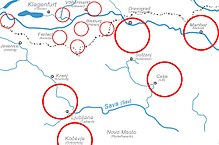Slovenska Koroška
As Koroška ( Slovenian for Carinthia ) parts of the country are the former crown land Carinthia referred to Yugoslavia and since 1918 Slovenia belong.
Slovenian parts of the former crown land of Carinthia (Slovenska Koroška)
As part of the country Spodnja Koroška or Slovenian Carinthia the Republic of Slovenia is referred to those parts of the Duchy of Carinthia, which after the collapse of Austria-Hungary at the end of World War I by the Treaty of Saint-Germain without referendum to the SHS State had fallen.
These are two geographically separated areas (yellow on the map):
- the Drautal downstream from the border up to and including Dravograd (Unterdrauburg) and the opening out there Mießtal ,
- the Jezersko (Zealand) extending above Kranj is (Krainburg).
The awareness of the Slovenian-Carinthia region (Koroška) and the expansion of some parts of the former Lower Styria is legitimized with the historical findings on the Principality of Carantania . Carantania is said to have extended into the area of the former Lower Styria, an assumption that was made in 2003 through the discovery of wall remains of the oldest church building from the Carolingian period in what is presumably Carantanian area in the area of the Georgskirche in Lechen , now a district of Windischgraz / Slovenj Gradec , is hardened. The Slovenian Lower Styria to the Savetal should also have been one of them. The historian Herwig Wolfram assumes that the Carantans developed their early medieval statehood on more than 35% of what is now Austrian and around 10 to 15% of Slovenian territory. The historical division of the Slovene-speaking area is still deeply anchored in the consciousness, customs and dialect of the residents, reinforced by the renaming of the towns of Guštanj (Gutenstein) and Črna (Schwarzenbach) to Ravne na Koroškem and respectively after the end of the Second World War. Črna na Koroškem ("in Carinthia").
In the course of the expansion of the Third Reich in World War II, all areas belonging to today's statistical region Koroška came under German civil administration from April 1941 until the end of the war . The connection of these areas took place depending on their previous affiliation to the Gaue Carinthia or Styria. As a result, the two countries were reborn in the Second World War under the name "Gau" in the Kronland borders from before 1918.
In the area of today's Koroška, around 15,000 people were murdered between May and August 1945 as part of the communist partisan justice system. The largest collective and mass graves were found in Holmec (200 dead), Poljana, Dravograd (200 dead), and in the mass grave site Liescha (around 800). Almost certainly lie in the mass grave Liescha (Leše) to the 60 Austrians next to the supposed Slovenian collaborators and Croatian refugees ( Domobranzen and Ustashe ), the dead from the entire Miestal were brought (Mežica dolina) there, as well as the victims of the massacre from Bleiburg . In Koroska, Slovenia, there are numerous unexhumed individual graves scattered in the forests. The exact number of old Austrians killed is not known. The largest mass grave is in Žančani near Slovenj Gradec (Windischgratz).
From 1945 the areas of today's Slovenian Koroška region were again part of Yugoslavia and now belong to Slovenia, which became independent in 1991. At the time of joining the EU in 2004, the Koroška statistična regija (Koroška statistical region) was created for common statistical purposes . It covers parts of the historical Lower Styria towards the south and coherently.
Individual evidence
- ^ Herwig Wolfram : Ethnography of early medieval Austria. Essay. In: Wilhelm Baier, Diether Kramer (ed.): Karantanien - mother of Carinthia and Styria. Hermagoras publishing house, Klagenfurt 2003
- ^ Slovenia Holidays: Ravne na Koroškem
- ^ Order of the Gauleiter of the NSDAP in Carinthia on the establishment of the NSDAP in the occupied areas of Carinthia and Carniola
- ^ Memoranda of the Gaugrenzlandamt NSDAP in Carinthia "Das Mießenal" and "Das Dreieck von Assling"
- ↑ Dežman Jože (ed.): Poročilo Komisije vlade Republike Slovenije za reševanje vprašanj prikritih grobišč 2005–2008, Ljubljana 2008.
- ^ Settlement fury in Croatia, p. 368.
- ↑ Kleine Zeitung - OA: The bloody border (13th continuation): It's been a long time since the murder, in: Kleine Zeitung 1953
- ↑ Florian T. Rulitz: The tragedy of Bleiburg and Viktring. Partisan violence in Carinthia using the example of anti-communist refugees in May 1945. Hermagoras Verlag, Klagenfurt / Ljubljana / Vienna, 2011. ISBN 978-3-7086-0616-3 , p. 262.
- ↑ Florian T. Rulitz: The tragedy of Bleiburg and Viktring. Partisan violence in Carinthia using the example of anti-communist refugees in May 1945. Hermagoras Verlag, Klagenfurt / Ljubljana / Vienna, 2011. ISBN 978-3-7086-0616-3 , p. 263
See also
- History of Slovenia
- Carinthian defensive battle
- Carinthian referendum
- Slovenian dialects
- Carinthia
- History of Carinthia
- Carantania
literature
- Arnold Suppan : Yugoslavia and Austria 1918–1938: bilateral foreign policy in the European environment . Publications by the Austrian Institute for East and Southeast Europe. tape 14 . Oldenbourg Wissenschaftsverlag, Munich 1996, ISBN 3-486-56166-9 ( limited preview in Google book search).
Web links
Historical region:
- Fran Ramovš's map of the Slovenian dialects from 1935. (gif file) (No longer available online.) In: The Slovenian Linguist. September 13, 2000, archived from the original on February 8, 2007 ; Accessed in September 2009 (English, from: Fran Ramovš : Karta slovenskih narečij v priročni izdaji . Cankarjeva založba, Ljubljana 1957 (Slovenian).).


